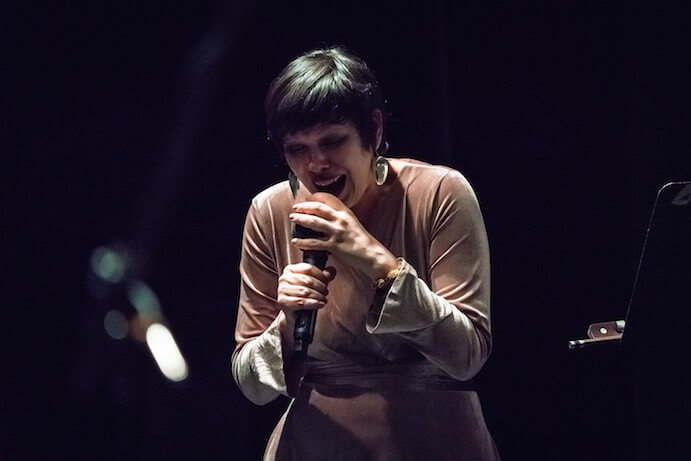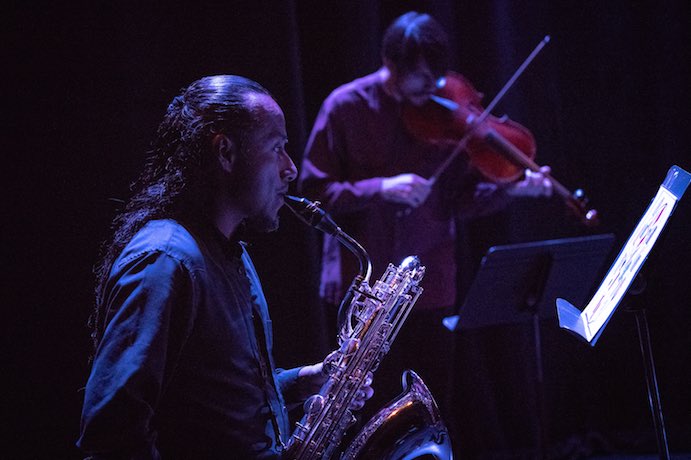For the past twenty years, the MATA festival has championed diversity. The 2018 festival opened on April 10 at The Kitchen with Liminar: Out of Bounds, a program that was grounded in a sense of immediacy. With seven works by seven globally diverse composers, the evening could have become a mismatched mélange; instead its inextricably current feel tied it together. Everything was of our time. Everything was of now.
The program opened with two works that seemed part musical composition and part performance art. It was odd when the lights dimmed without performers on stage, but within moments, soprano Carmina Escobar materialized on a screen, broadcast from a shower on the third floor of The Kitchen. Sergey Khismatov’s D-Musik (2015) was more conceptual than it was musical—a gargling soprano and accompanying showerhead spray explored the timbres of water when manipulated by human interaction. The physicality required of Escobar made the performance visually compelling, as she had to move her entire body to allow the long tone gargling to become different rhythmic figures, but musically it felt more of an artistic experiment than a fully formed composition.

Carmina Escobar performs at MATA 2018–Photo by Steve Pisano
Experimentation took on a different form in Tania Rubio’s Siete colores de la luna (2013) as the members of Liminar slowly moved through the space, playing their individual material while interacting with each other. The largely static work garnered its interest equally from overlapping textures and blended sounds as well as patterns of physical motion (guided by lighting changes). When combined, the musical and spatial effects become something akin to a slowly rotating kaleidoscopic orb. Occasionally, Escobar’s vocal interruptions nudged the gently revolving mechanism: shrill whispers, spoken words, and eerie vocal fry giggles highlighted her versatility. Through this experiential work of guided improvisation, or piece of “sound object theater” as Rubio calls it, she hopes to blur boundaries so the ensemble and the audience have equally important roles in producing and absorbing material.
While visual exploration opened the program, three later works directly questioned sound, or more specifically, the noises around us. Daniel Silliman’s the two names (2018), a MATA commission and world premiere, looked at sounds that fill our modern world. From “the hum of the refrigerator (and its remarkable absence when it shuts off)” to the “clanging of a pipe,” flute, viola, cello, percussion, and soprano gave voice to these ordinary noises. Percussionist Diego Espinosa’s amplification of scraping different surfaces plus Escobar’s vocal sputters, shrieks, and hisses gave way to an electronic whirr that unfortunately drowned out the ensemble.
Industrial noise was the focus of Annie Gosfield’s Voices Over the Buzz and Clatter (2018), another MATA commission and world premiere. Here, the machines took center stage. The opening ambience of a factory awoke to driving rhythms, melodic fragments, and a variety of percussive clanks. The members of Liminar (making their East Coast debut on this performance) seemed to delight in the forward-moving intensity. Their previously focused clarity gave way to technically precise licks and a sense of radiating enjoyment in their collective experience.
Liminar
Also receiving its world premiere, Joe Bates’ piano quartet, A Noise So Loud (2017), took the tonality of a conventional chamber ensemble and interwove scordatura viola and cello to utilize an equal-tempered 24-tone scale. Here, there were not explorations of noise or forays into visual design, yet the traditional structure and novel tuning formed a world that seemed familiar yet was ultimately quite foreign. Heavy vibrato and repeated rocking rhythms gave it a Romantic feel, but the manipulation of pitch remained unsettling.
Carlos Iturralde’s Fata Morgana (2013/15) returned to commonplace sounds as viola, cello, and bass became creaking floorboards, squeaky doors, dropped bouncy balls, and broken kazoos. Using what looked like small rubber pieces on sticks, they moved these devices all over their instruments—around the sides, across the back, up and down the strings—to create thumps, moans, and scrapes. After becoming entrenched in this world of wonderfully quiet irregularity, bass clarinet, baritone saxophone, and flute added to the texture from a perch above and behind the audience. The offstage group attempted to mimic the sounds of those onstage, which was initially intriguing, but lost its interest as it continued without developing further.
Liminar performs at MATA 2018–Photo by Steve Pisano
The final work, Juro Kim Feliz’s Pangkur (2017), continued the use of onstage and offstage groups through an exploration of Javanese gamelan aesthetics where two independent pieces were performed simultaneously. The onstage duo of percussion and piano created rapidly interlocking patterns and melodies with an impressive array of percussion: wood blocks, crotales, marimba, a variety of drums, and triangles. Quietly uttered vocalizations added to this texture, which at first seemed like a sort of secret whispered conversation, but became words—excerpts from macapat poetic texts in the Javanese language. This shimmery and punctuated vocal exchange recalled Escobar’s intensely varied vocalisms, bringing the performance full circle.
For all of the differences in form, inspiration, and style of the individual works, there were equally as many overlapping currents. The immediacy of each piece, whether through an analysis of human and machine, the presence of noise in our technologically expanding world, or the blurring of art maker and art consumer, created a program that felt entirely of our day. Du Yun, MATA’s Artistic Director, added her take on the relevance of the festival: “I am glad we are now talking about diversities in our society, because social and cultural change needs to start from somewhere.” As the conversations MATA has been challenging for the past twenty years are now coming into focus on a global scale, the works they present seem increasingly relevant. MATA 2018’s opening performance proved that stretching oneself to the limits, out of bounds, may be one way to start speaking about our rapidly changing world.

